Shakes Tembani has a distinctive, stylized painting technique inviting viewers to contemplate the beautiful in the seemingly ordinary by using bold and flat colours. Inspired by the everyday experiences faced by him and his community and his love of music and fashion, Tembani has developed his style recently to incorporate detailed stripes, butterflies and bright patterns.
Read our interview with Shakes Tembani below, and watch a short film behind the scenes with the artist in his studio in Nyanga in Cape Town:
Artist Biography:
Tembani grew up in the New Crossroads township (Cape Town) where he still lives and works. In 1998 he completed a Certificate in Visual Arts with the Community Arts Project. This was followed by a Certificate in Screen-printing, paper-mache, fabric painting and craft at Ruth Prowse College of Art and Design (1999). He then completed Diploma in Adult Education at the University of Cape Town in 2003 and a Product Design and Development Course at Madesa the next year. Tembani was a resident artist at the Castle of Good Hope Art Studios for a few years. He has had a number of solo exhibitions and has participated in many group exhibitions both locally and abroad. Tembani’s work has been commissioned by companies and institutions and appears in several collections globally.
Your portraits don’t include many facial features, showing mostly shadows, sometimes a mouth. How did this style develop?
When I was a street photographer and I used to take pictures of people randomly and wanted to use them for my painting. But then people would complain that I will put it on Facebook without their permission. So I would say no, I've got this technique: let me not paint the details of their faces, I came up with a way of painting their faces without showing their features.
Sometimes tourists will come to the township and people here will pose for their pictures. But now, everyone has realised and gets angry that the tourists could take the photos and then make money out of us. It's difficult, now they sometimes want to take your camera and delete the photos.
So I often source photos from the Internet now, but I still don’t show the features or make it too recognisable. I also still have a lot of photos that I took that I use for my references.
My faceless portraits have taught me how to tell stories without using expression.
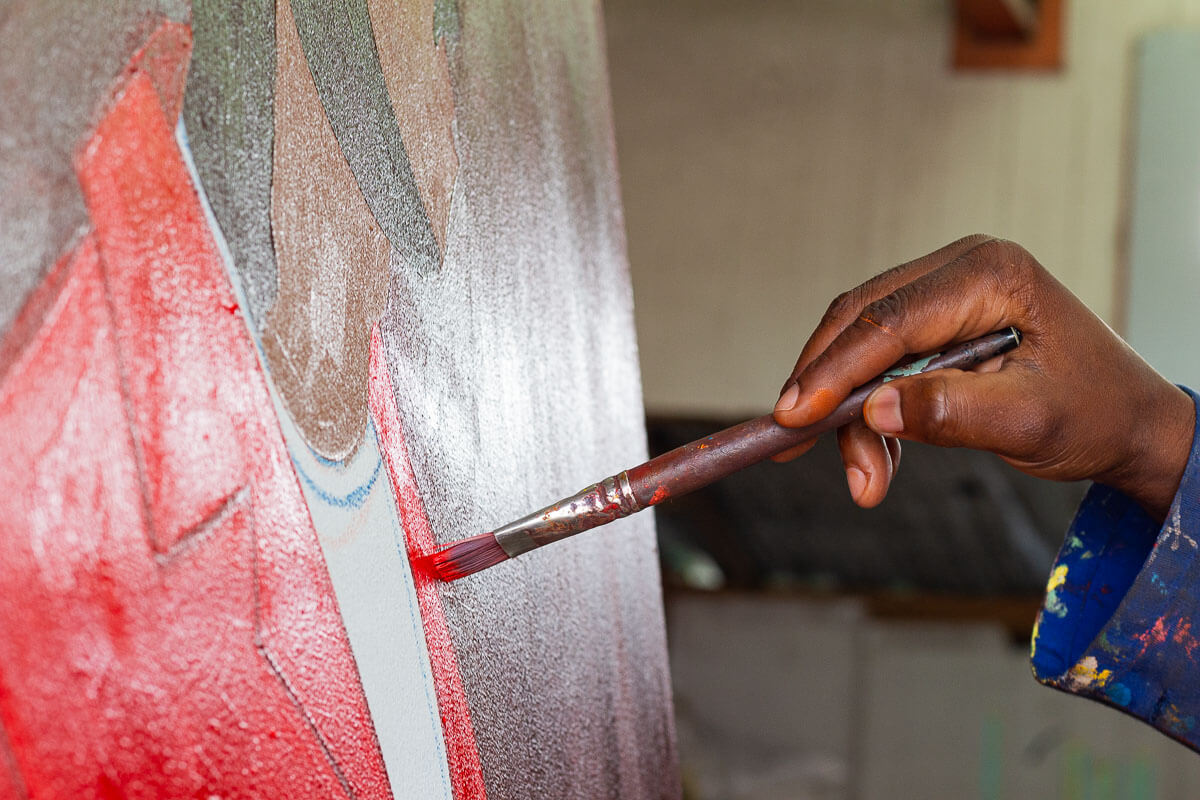
You are incorporating a striped background in many of your paintings at the moment, why is that?
I started adding a stripe in my paintings last year. It was in spring when I came up with this style - I was experimenting and trying to come up with something new. Before, I used to paint people going to work, or to church and then I thought that I had been doing that kind of style for too long. It's like if you were to meet me, I’m still speaking the same conversation.
So, I decided to try this kind of style now, to be more contemporary and not too stuck in one same spot, to experiment!
By adding stripes, I am also trying to be different from other artists. My stripes must be thin, not too thick. I’m trying to have my own identity.
During the COVID lockdowns you created portraits of people wearing masks. Now you’re creating more portraits of men in your ‘Cool Dudes’ series – what influenced this?
I think the Cool Dudes were mostly influenced by fashion and the music that I listen to – Hip hop.
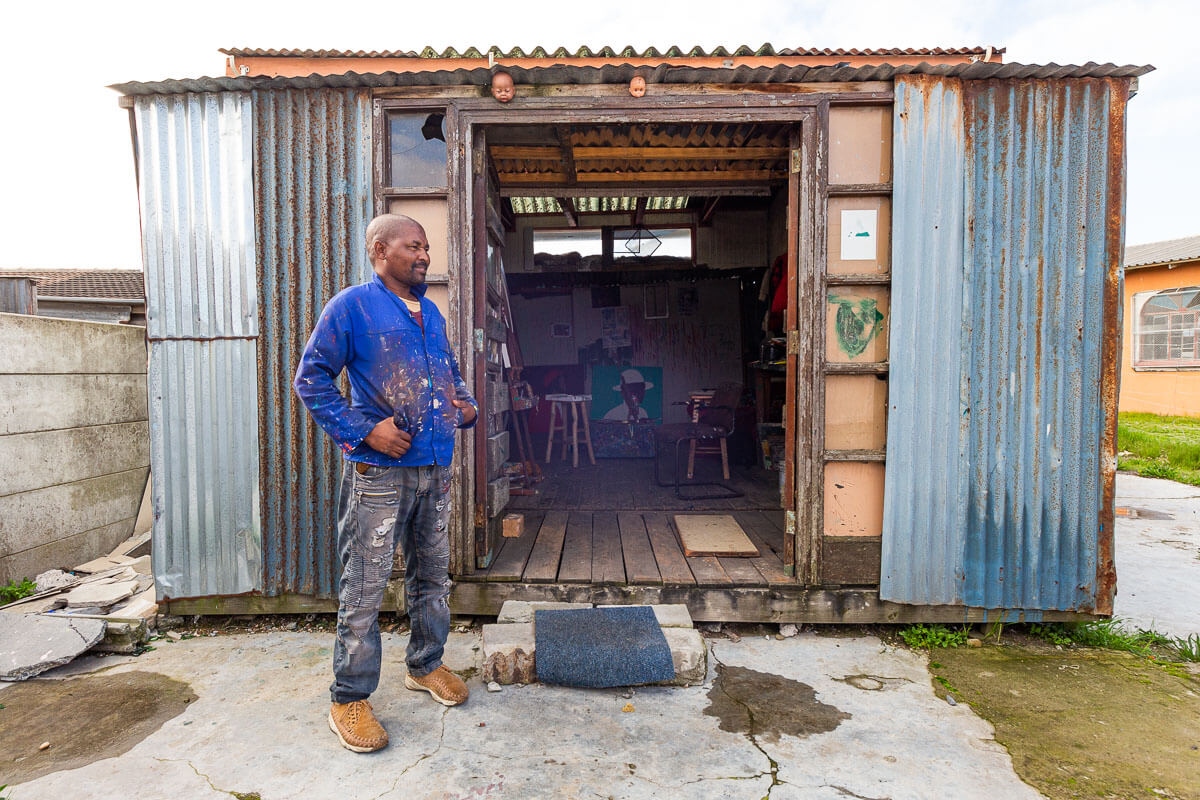
Who is your favourite Hip Hop musician?
My favourite artist is probably Tupac Shakur, I used to listen to him a lot.
The Cool Dudes’ style definitely came from there - the fashion and the music that I listen to.
Why did you choose to add Butterflies into your paintings?
For me a butterfly means celebrating a new life. When the butterfly is growing up, it changes from a caterpillar to the cocoon to the butterfly and then it flies. When it flies away, it has a lot of freedom. For me, that is similar to my style now. I was celebrating my new style with the butterfly, new life.
What does your process of creating one of your paintings look like?
Once I have the reference photo of the person, I have to blow it up big on the canvas first.
Then I paint the background, and when the paint is dry, I add some stripes using masking tape.
I paint each and every line, layers over each other – waiting for the lines to dry and then paint the next line over it again.
What really excites me sometimes is when I see the way I want the painting to be. When I can see all the colours are coming right and mixed the way I want, when the painting turns out the way I planned it.
I work on a few paintings at a time, so that they have time to dry in between. I try to work on 2 paintings a day.
Do you listen to music when you work?
Yeah, I like the radio. Most of the time I listen to Radio 2000, I like music.
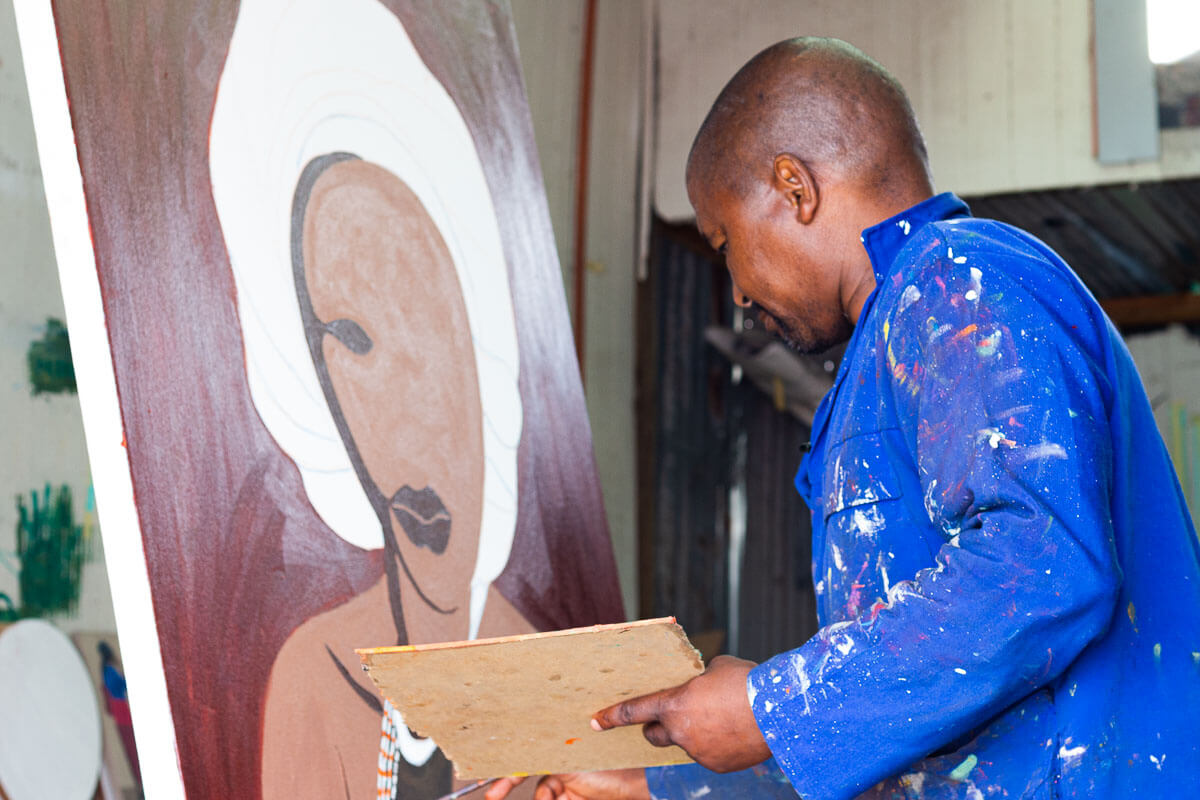
How did you originally start painting? How did you get into art?
When I started my art like after high school I want to camp - the community art project in 1997 and then I also went to 3 different art schools – Ruth Prowse was one of them.
Since I was young I was very artistic, I used to draw a lot with my friends. We used to draw Cowboys, sometimes action movie stars. Also cows or some animals, and then some people doing bodybuilding - we used to like Arnold Schwarzenegger!
Which South African artists inspire you the most?
In South Africa there are lot!
My biggest inspiration is maybe Deon Cupido – his work and technique inspires me a lot.
Ricky Ayanda Dyaloyi, he exhibits at Everard Read Gallery.
And in Joburg, Blessing Ngobeni. I think artists who work hard inspire me.
I'm trying to have my own style. I don't want to copy someone else, I want to be unique in whatever I do. I have to have my own signature. Lots of people and artists inspire me all the time. Another artist who also inspired me with these lines is Henk Serfontein - his stripes and lines used in his Abstract work at Spier Arts Trust are very beautiful.
You have participated in many residencies and you have work in collections all around the world. What are some of your accomplishments that you are most proud of?
My favourite was having my painting was exhibited in London, in Soho in 2019.
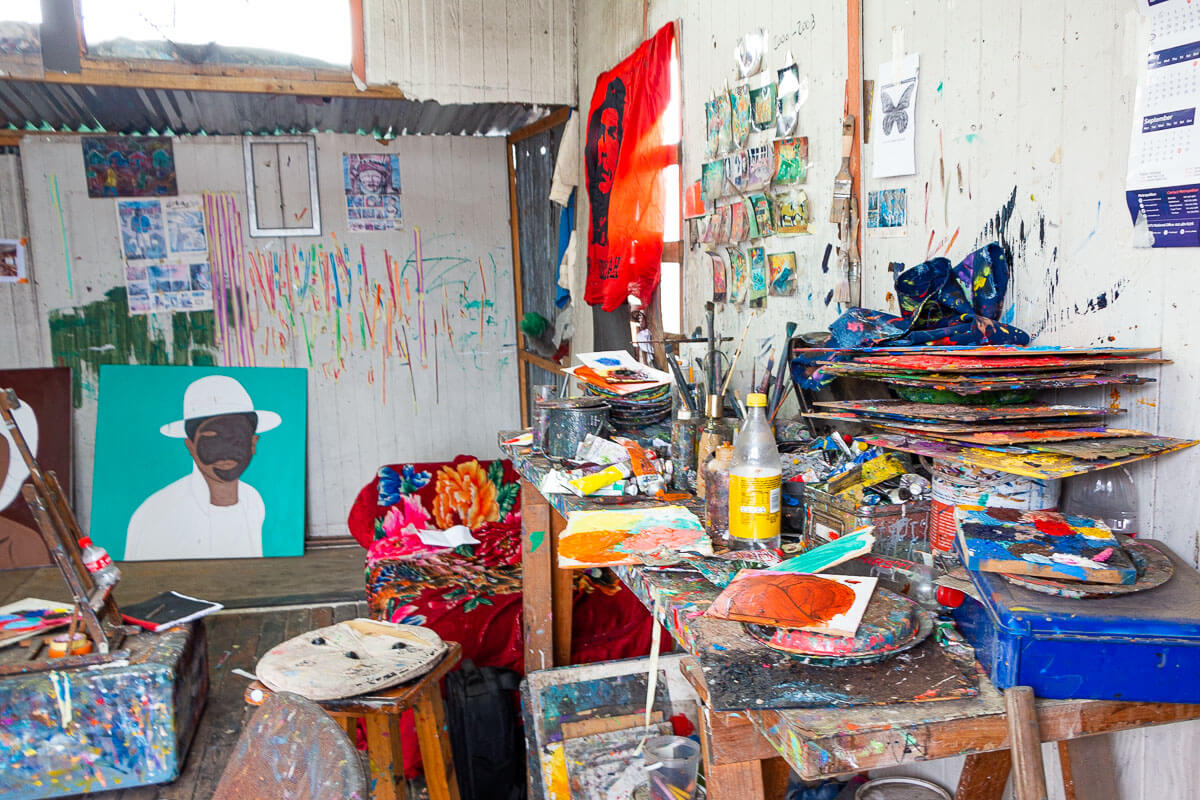
Do you think it is important to keep up to date with the art scene and visit many exhibitions, to see other artists works and trends of the moment?
Yeah, it's important to see what is new and what is happening - you learn a lot about other artists’ technique and what everyone is doing.
Being at the Castle of Good Hope helped me a lot, because we had some crits there - maybe once a week. This was a great experience to be able to get feedback and talk about our art, hear about other artists’ work. Also when I submit to the Creative Block at Spier, they give me some feedback: what you must improve, what you can add. This has also helped me a lot.
Those two institutions have been very influential.
I think sometimes if you don't get a crit, you don't know what you are doing. It’s very good to get feedback. Sometimes people will say it's beautiful, but sometimes they’ll say it's not right. Inside, you know that as an artist you need to grow more. I think I spent about seven years there at the Castle art studios. It trained me a lot, it was very good.
And then after I spent so much time there, I decided it was time to be on my own. It is great to share with others, but then it got too much – too many artists.
I still sometimes invite friends over to my studio to give me a crit – I ask them what they think of my style, listen to their feedback. I have had a really good response from other artists about my new technique, this new style I am working on. But also, some of them steal my ideas and use it in their work!
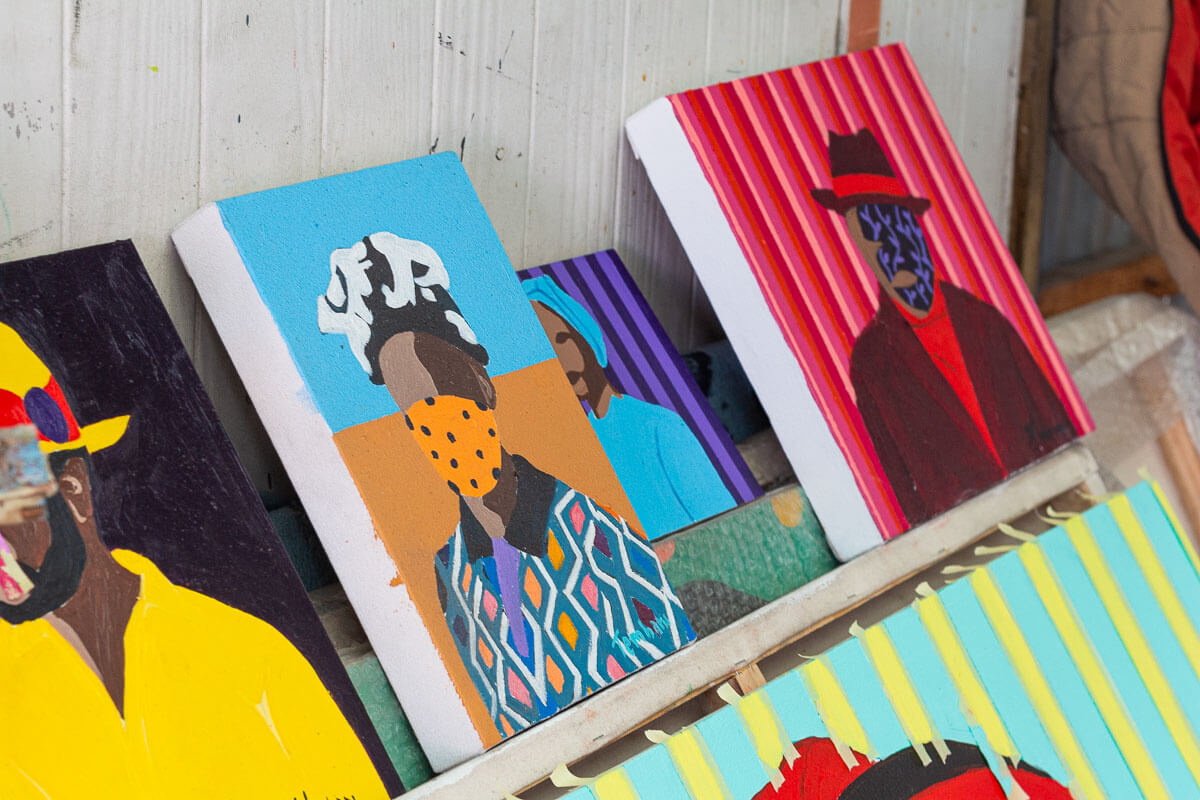
What do you hope to accomplish? And can you share any plans you have for this year?
With my art, I hope that I can become a household name and my style can be instantly recognised.
I'm planning to have an exhibition, maybe at the end of the year or in September. But I have not yet approached any Galleries, I just want to keep painting and when I have about 12 finished works, I will decide and apply or ask. I think, let me just keep painting until I feel I am ready.
View more paintings by represented artists >>

